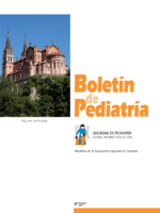Secuelas cognitivas a largo plazo en un caso de daño cerebral adquirido
Y. Ramírez Benítez , H. Marchena Morera , E. Bausela Herreras
Bol. Pediatr. 2010; 50 (214): 291 - 296
Introducción: El daño cerebral adquirido en edades pediátricas ha aumentado en los últimos años y, con ello, una eficiencia en los Servicios de Neurología. El problema científico potencial está ahora en las secuelas neuropsicológicas y en la posible rehabilitación cognitiva a largo plazo. Material y método: Un estudio del caso revela que, después de 4 años del trauma, están vigentes las consecuencias neurológicas y las secuelas neuropsicológicas afectando al desempeño académico y social del niño. El perfil neuropsicológico se realizó con el apoyo de la batería Luria-Diagnóstico Neuropsicológico Infantil (Manga-Ramos, 1991) y con la batería SESH.1.1 (Álvarez, 1989). Las pruebas de inteligencia, conducta, neurofisiologías y neuroimagen fueron evaluaciones complementarias al perfil. Resultados: Inteligencia: ligeras diferencias entre las subescalas verbal y manipulativas, refiriendo deficiencias cerebrales. Neurofisiología, EEG: signos de sufrimiento cortical difuso con un trazado pobre para su edad. Neuroimagen anatómica: ligera asimetría a nivel ventricular lateral con mayor tamaño en el lado derecho. Conducta: dificultades en el aprendizaje. Neuropsicología: puntos débiles: sistema ejecutivo (categorización, inatención, perseveración, inteligencia fluida), memoria visual, habilidades académicas (lectura y aritmética) y habilidades viso-perceptuales. Puntos fuertes: tiempo de reacción. Conclusiones: Según los síntomas neurológicos, el caso es definido como leve pero, según las alteraciones neuropsicológicas, el caso no es tan leve. El daño cerebral temprano limitó considerablemente los componentes ejecutivos y atencionales del sistema cognitivo del niño en el desarrollo.
Long term cognitive sequels in a case of acquired brain damage
Introduction: Acquired brain damage in pediatric ages has increased in recent years and with it, efficiency in the neurology services. The potential scientific problem is in regards to the neuropsychological sequels and the possible long-term cognitive rehabilitation.
Material and methods:Acase study revealed that after 4 years of the trauma, the neurological consequences and neuropsychological sequels are still present, these affecting the academic and social performance of the child. The neuropsychological profile was obtained with the help of the Luria's Diagnostic Neuropsychological Battery-Children's version (Manga-Ramos, 1991) and with the SESH.1.1 battery (Álvarez, 1989). Intelligence, behavioral, neurophysiological and neuroimaging tests were evaluations complimentary to the profile.
Results: Intelligence: There were mild differences between the oral and manipulative subscales, regarding brain deficiencies. Neurophysiology, EEG: signs of diffuse cortical suffering with poor tracing for the age. Anatomical neuroimaging: Mild asymmetry on the lateral ventricular level with larger size on the right side. Behavior: learning difficulties. Neuropsychology: weak points: executive system (categorization, lack of attention, perseveration, fluid intelligence), visual memory, academic skills (reading and arithmetic) and visual-perceptual skills. Strong points. Reaction time.
Conclusions: According to the neurological symptoms, the case is defined as mild, but according to the neuropsychological alterations, the case is not so mild. Early brain damage considerably limited the executive and attentional components of the cognitive system of the child in the development.
Artículo completo (PDF) (116 kb.)
- Psicología
Buscar en el boletín
Año 2010, Volumen 50, Número 214

Boletín completo en PDF (1288 kb.)
En esta edición...
- Editorial (1 artículos)
- Revisiones (2 artículos)
- Originales (1 artículos)
- Casos clínicos (4 artículos)
- Acceso libre a la información científica (1 artículos)
- Curso de Nefrología Pediátrica (2 artículos)
- Trastornos del aprendizaje (1 artículos)
- En la jubilación del Dr. Emilio Álvaro Iglesias (1 artículos)
- Fe de erratas (1 artículos)
- Noticiario (1 artículos)
- Índices (1 artículos)